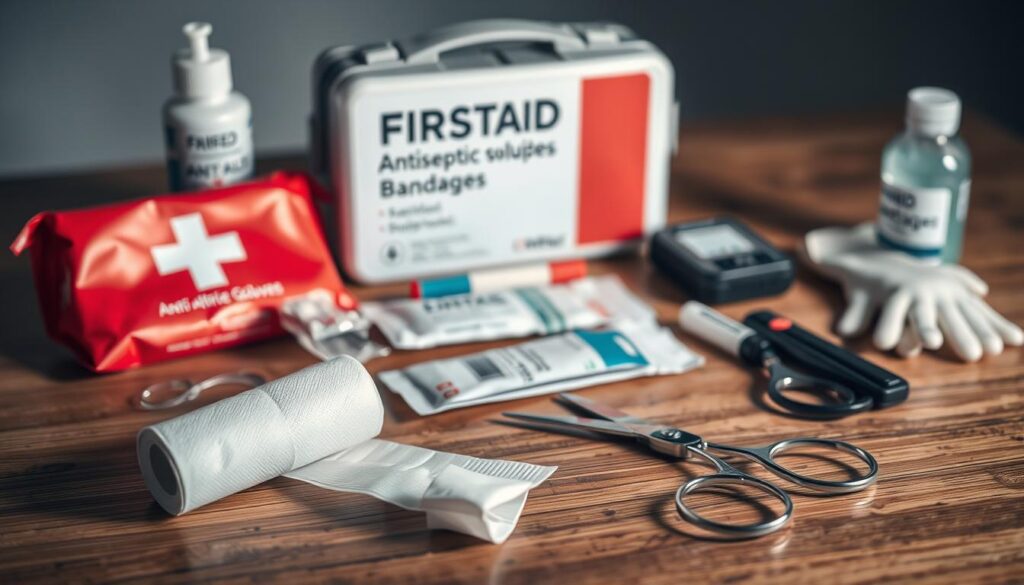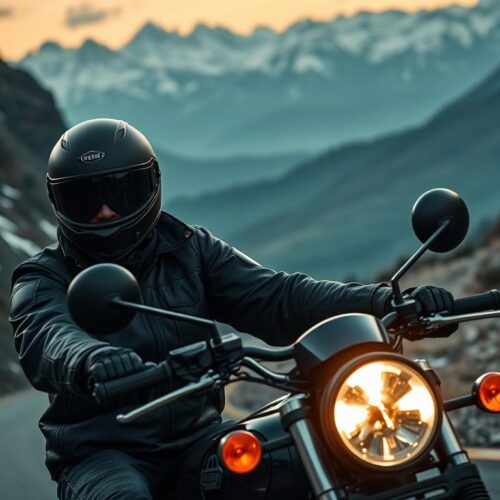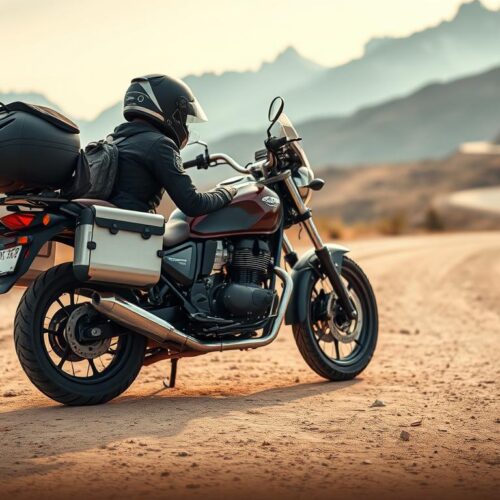Riding a motorcycle is thrilling, but it’s not without risks. That’s why it’s crucial to have a well-stocked first aid kit for your bike. A good motorcycle first aid kit means you’re ready for emergencies.
Whether you’re going on a long trip or just cruising nearby, being prepared is key. With the right gear, you can tackle any issue that comes your way confidently.
Importance of a Motorcycle First Aid Kit
Carrying a motorcycle first aid kit is crucial for riders. Getting medical help right away might be tough in places where few people go or there’s little traffic. Having the right first aid supplies can really change things when in a pinch.
Accidents can happen for many reasons, like surprising road issues or bike problems. Having a first aid kit ready means you can care for yourself or others after an accident. Acting quickly can lessen harm and help with faster healing.
Being ready with a first aid kit shows you’re serious about safety. A well-prepped kit means you’re set to tackle sudden troubles. This careful planning matters for your safety and helps others on the road too.
| Item | Purpose |
|---|---|
| Adhesive Bandages | To cover small cuts and scrapes |
| Gauze Pads | To absorb blood and protect larger wounds |
| Antiseptic Wipes | To clean wounds and prevent infection |
| Tourniquet | To apply pressure to serious bleeding |
| CPR Mask | To perform rescue breaths safely |
Essential Items for Your Kit
Packing the right essentials in your motorcycle first aid kit is key for safety. Start by adding various sizes of adhesive bandages and gauze pads. They are needed for different wound types. Antiseptic wipes are also essential. They help clean cuts and scrapes, preventing infection.
Don’t forget to include disposable gloves to keep things clean while treating injuries. Scissors are handy for cutting tape or clothing, making it easier to treat wounds. Pain relievers are important for emergency relief. Burn treatment ointments are also crucial for skin injuries.
Include a first aid manual for guidance on handling different injuries. It’s also vital to have emergency contact information in your kit. This mix of items ensures you’re prepared for anything. From small scrapes to serious injuries, you’ll be ready until you can get medical help.
| Item | Purpose |
|---|---|
| Adhesive Bandages | Cover and protect minor cuts and scrapes |
| Gauze Pads | Absorb blood and protect larger wounds |
| Antiseptic Wipes | Clean wounds to prevent infection |
| Disposable Gloves | Maintain hygiene during treatment |
| Scissors | Cut tape or clothing for easier access |
| Pain Relievers | Provide relief for pain during emergencies |
| Burn Treatment Ointments | Soothing care for burn injuries |
| First Aid Manual | Guide for treating various injuries |
| Emergency Contact Information | Ensure access to help when needed |
First Aid Supplies Breakdown
Understanding your first aid supplies is vital for quick action during emergencies. Your motorcycle first aid kit needs basics like adhesive and gauze bandages. These are important for cleaning and shielding wounds. Antiseptic wipes clean the area before you put on dressings. Adhesive tape helps bandages stay in place, keeping dressings stable.
Add sterile gloves to your kit to avoid contamination. Tweezers help you remove things like splinters safely. Cold packs are good for reducing swelling and easing pain. Spending on good medical supplies means they’ll work right when you really need them. This helps you be ready for any situation.
Additional Tools for Convenience
When you’re putting together your motorcycle first aid kit, think about adding some extra tools. Tools like a multitool, for instance, a Leatherman, are super helpful. They let you fix little issues yourself, right there on the spot. A Leatherman is great because it combines pliers, scissors, and screwdrivers, ready for many tasks.
Adding a tire inflator to your kit is also a wise move. When flat tires happen, and they often do, a portable inflator can get you back on the road fast. Also, packing a spare bolt kit could be a lifesaver. Bolts can come loose or go missing, and that’s a risk to your safety and your bike’s performance. With these tools, you won’t have to wait around for help.
Check out this table to see key additional tools that boost your motorcycle maintenance and safety on the road:
| Tool | Function | Benefits |
|---|---|---|
| Leatherman Multitool | Multi-functional repairs | Versatile solution for various issues |
| Tire Inflator | Inflate flat tires | Eliminates wait time for help |
| Spare Bolt Kit | Replace lost bolts | Prevents mechanical failures |
| Flat Repair Kit | Seal punctured tires | Quick fixes for unexpected issues |
| Portable Jump Starter | Start dead batteries | Avoids being stranded due to battery failure |
By having these tools, you’re ready for anything that comes your way. This means you can ride with confidence and feel secure, knowing you’re prepared for emergencies.
Organizing Your Motorcycle First Aid Kit
Having a well-organized motorcycle first aid kit is vital. Start with clear, tough containers so you can quickly find what you need. Put items into groups based on their use. This way, medical supplies, tools, and important information like phone numbers and first aid instructions are easy to grab.
Check your kit often to replace old items. Make sure it’s ready for your trips. Think about common problems you might face and plan your kit accordingly. This helps you be prepared on the road.
| Category | Examples of Supplies |
|---|---|
| Medical Supplies | Adhesive bandages, antiseptic wipes, gauze pads |
| Mechanical Tools | Multi-tool, tire repair kit, flashlight |
| Informational Items | First aid manual, emergency contact list, accident report form |
A good first aid kit can make a big difference in emergencies. It can lessen the severity of injuries, keep you safer, and help during surprise situations on your ride.
Training and Preparedness
Training helps you get ready for emergencies when you’re on the bike. Learning to use everything in your motorcycle first aid kit is key. By taking courses from groups like the American Red Cross, you learn life-saving skills for the road.
Knowing how to handle first aid can save lives when every second counts. Practicing these skills often makes you better at dealing with emergencies. First Aid mobile apps also give you quick tips when you need them.

Make a plan to keep your skills sharp and your knowledge fresh. Staying prepared means you’re always ready for what might happen, giving you confidence. Start training now to make your rides safer.
Packing and Storage Tips
When packing your motorcycle first aid kit, think carefully. You want all essentials to fit and stay compact. Choose waterproof bags or roll-top containers. They’re light but sturdy and keep everything dry.
Always put your first aid kit in the same place on your motorcycle. This makes it easy to find when you need it fast. Packing smartly saves time looking for items when there’s an injury.
- Group items by functionality—bandages, antiseptics, and tools.
- Label compartments for quick identification.
- Secure loose items to prevent movement during rides.
Good storage and these packing tips make your first aid kit work best. Following these suggestions means you’ll be ready for emergencies.
Enhancing Your First Aid Kit
Making your motorcycle first aid kit fit your needs is key. Add special meds that you might need, like allergy pills or must-haves for emergencies. For example, if you ride in the woods a lot, having insect bite cream can really help.
Checking out the places you go to can help you pick the right stuff for your kit. You may want to throw in more bandages or special dressings for accidents that can happen on your rides. Doing this makes your kit more suited to you and gives you peace of mind.
To get your kit organized with these extra items, look at the table below. It shows what personal items you can add based on where you ride:
| Personal Item | Usage |
|---|---|
| Allergy Medication | Provides relief from allergic reactions. |
| Insect Bite Cream | Soothes irritation from insect bites. |
| Extra Bandages | Covers minor cuts and abrasions. |
| Thermometer | Measures body temperature to check for fever. |
| Personal Prescriptions | Ensures you have necessary medications available. |
Interstate Regulations and Guidelines
Knowing the rules for motorcycle first aid kits in different states is very helpful. Each state has its own list of items that must be in these kits. Before you ride across states, look into these rules to make sure your kit is up to standard.
Understanding state guidelines helps you follow the law and stay safe. As you travel, you’ll find that some states have special requirements for your kit. This info helps you pack right and ride safely, ready for any emergency.
| State | Required Items for First Aid Kits | Additional Recommendations |
|---|---|---|
| California | Adhesive bandages, antiseptic wipes, tweezers | Burn cream, emergency blanket |
| Florida | Adhesive dressings, elastic bandage, first aid manual | Instant cold packs, scissors |
| Texas | Gauze pads, antiseptic solution, rubber gloves | Tourniquets, instructional pamphlet |
| New York | Splint, adhesive tape, first aid guide | Emergency contact card, pain relievers |
Adding these items to your kit helps you meet the rules of each state. Learn what each place requires to make your ride safer.

Conclusion: Riding Prepared
Getting ready for emergencies is key when you’re on a motorcycle. Having a first aid kit ready, with the right supplies and some extra tools, is a big help. This kit doesn’t just give you peace of mind. It also lets you deal with surprises confidently.
Checking your first aid kit often is really important. Get to know what’s in it and practice how to use everything. This way, you’re ready for anything the road throws your way. Being well-prepared makes riding to new places more enjoyable and less stressful.
Being prepared can save your life. Knowing how your motorcycle first aid kit works and taking steps to stay safe mean you can enjoy your rides without worry.




